The St. Kitts Railway
Mark Bartlett
A short history
St. Kitts (formerly St. Christopher) is one of the Leeward Islands in the Caribbean. Formerly a British colony, along with its neighbouring island it achieved independence in 1983 to form the nation of St Kitts and Nevis.
St Kitts: Rounding the northern tip of St. Kitts the Dutch island of Sint Eustasius comes into view from a train heading for La Vallee. Mark Bartlett 18/02/2017
Sugar cane was grown on St Kitts from 1640 onwards and by the end of the 18th century over 200 estates were producing cane. Many of the old sugar mills can be seen around the island but in the 20th Century, with competion it became less and less profitable and it was realised that for the sugar production to continue it had to be concentrated at a single factory and this was constructed in Basseterre, now the capital, in 1912. Construction of a 2 foot 6 inch gauge railway also began to link the outlying estates with the new factory and in stages this was continued until in 1926 the railway formed a thirty mile circle around the island.
Interestingly, the railway only operated seasonally from February to June as its sole purpose was the sugar crop. Initial motive power was seven Kerr-Stuart 0-4-2PT locos but these were replaced by diesels in the late 1950s. The frame, wheels and boiler of No.5 apparently survive in very poor condition on the island.
The initial diesel fleet was supplied by Hunslet new to the island but in later years they were supplemented by locos of other manufacturers coming second hand from other Caribbean systems that were closing. Full details of the various locos in the fleet can be found in an excellent illustrated article on the International Steam website: International Steam

Basseterre Sugar Factory: The central sugar factory at Basseterre which was in operation between 1912 and 2005. The St Kitts Railway made a thirty mile circuit of the island and operated seasonally to bring harvested cane from the various estates to this central processing plant. Before the 21st century tourist trains sugar cane was the sole traffic on the line. Mark Bartlett 18/02/2017
Post sugar operations
The railway allowed sugar cane farming to continue on St Kitts long after other islands had ceased production but it was steadily losing out to European beet production. The factory was taken over by the government in 1972 but had become unprofitable and the government took the decision to close the factory in 2005. The last sugar train ran on 31st July 2005.
Prior to this however, on 28th January 2003, the privately owned railway had started running tourist trains. For the first three years these ran alongside the sugar crop trains and round the full circuit. Once the sugar trains ceased however, and based on feedback from the cruise companies who were the principal customers, the railway passenger services were concentrated on the eighteen miles from the depot at Needsmust (near the international airport) up the east side Atlantic Coast and round the top of the island before terminating at La Vallee. Here rail passengers transfer to buses that have brought another group of passengers from Basseterre to make the return trip – a very convenient arrangement for all concerned.
The passenger trains are formed of five purpose built double deck cars with air conditioned saloons down stairs and canopy covered open seated areas upstairs. They were built in the USA specifically for this line and are supported by a ‘generator car’ providing the on train services. The little 110-160hp sugar train locos were clearly not powerful enough for these big trains and alternative motive power arrived in the form of three FAUR Romanian built Lyd2 (0-6-0DH) locomotives. These were purchased second hand from Poland and have been re-engined with Henschel 450hp power units, although No.3 is presently non-operational. They also had to be re-gauged from 750mm to 762mm to be compatible with the imperial St Kitts tracks. A new bogie diesel-electric locomotive was reported to be being built by Global Locomotive in the USA to enter service in 2014 but on my visit in 2017 the services were still in the hands of the 0-6-0.

La Vallee: Circle the wagons!. Looking a little like a scene from a Western film, a St Kitts Scenic Railway train sits on the La Vallee turning circle, the present limit of operations. At this point train passengers transfer to buses to return to Basseterre by road while those who have arrived on the buses return by train along the Atlantic coast. Mark Bartlett 18/02/2017
The line today
The eighteen mile St Kitts Scenic Railway as it is now known runs east from Needsmust station (and depot) to the Atlantic coast of the island before turning north to run with the sea on one side and the volcanic mountains that form the islands backbone on the left. There are numerous valleys (or ghuts) on the coast and at each one the railway turns inland to go around the head of the valley, often using spectacular unfenced steel viaducts. Weaving in and out of houses and fields and passing a number of old sugar mills the train heads steadily northwards through beautiful scenery. At the north end of the island there are views of the Dutch island of Sint. Eustasius before the train turns south again to run through further rural scenes to the current limit of operations at La Vallee. Here it passes over points that form a junction with the disused section of line to Basseterre before entering the return loop station where the buses arrive with the next group of passengers and take those from the train back to Basseterre via the west coast road.

Needsmust Depot: Locomotives at Needsmust Depot, St Kitts. No.15 has been renovated and is used for occasional maintenance trains. Two stablemates from sugar cane days lurk in the right hand shed while one of the Romanian built hydraulics is undergoing a repaint. The modern building behind is the terminal of the airport. Mark Bartlett 18/02/2017
Impressions
The Scenic Railway is primarily aimed at cruise passengers, who form a large percentage of the visitors to the island. Although I was looking forward to my visit I had seen the pictures of the bright double deck coaches and did think it might be a very ‘touristy’ line. In actual fact it was a delight to travel on the railway. Although little remains from the sugar cane days the old mills and transfer sidings were visible and pointed out by the train guide and the twists and turns over the viaducts and around the ghuts meant there was always a new vista to appreciate. Much of the scenery of the island also reminded me of Scotland so if you are fortunate enough to get the opportunity to visit St. Kitts I heartily recommend you do so and whilst there take in this wonderful railway too. If you need any further encouragement the two complimentary rum punches served on the journey should clinch it!

La Vallee: Lyd2 Faur locomotive, one of three Romanian built 450hp 0-6-0s bought by the St Kitts Railway from Poland to haul the Scenic Railway passenger trains, stands on La Vallee loop at the northern limit of services. The line originally continued down the west coast to form a loop but that section has not carried trains since 2005. Note - Lyd2 designation: L=narrow gauge, y=3 axles, d=diesel power and 2=hydraulic transmission. Mark Bartlett 18/02/2017
St Kitts
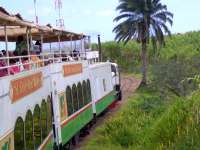
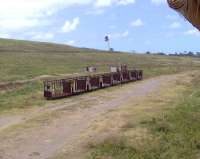
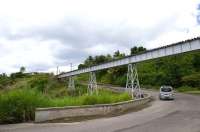
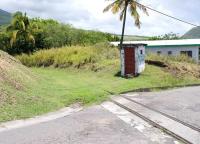
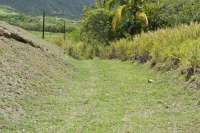
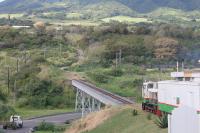
![Former sugar cane transfer station, seen from a passing train on the St Kitts Scenic Railway. This appears to be the same location photographed in 2009 See image [[23010]] and the abandoned trucks clearly haven Former sugar cane transfer station, seen from a passing train on the St Kitts Scenic Railway. This appears to be the same location photographed in 2009 See image [[23010]] and the abandoned trucks clearly haven](/__cache/thumbnails/58000/58387.jpg)
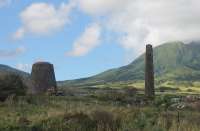
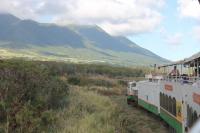
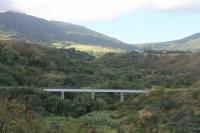
La Vallee
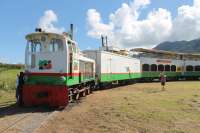
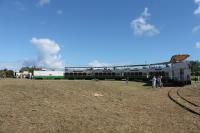
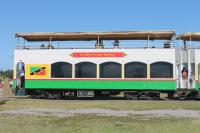
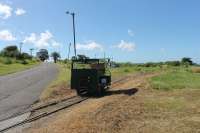
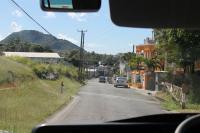
Needsmust Depot
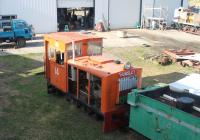
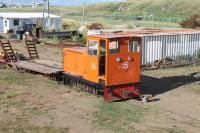
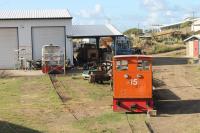
Basseterre Sugar Factory
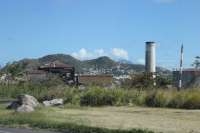
"The Last Railway in the West Indies"
Opened 1912 - 1926
Length 18 miles
Gauge 2ft 6in
St Kitts Scenic Railway

